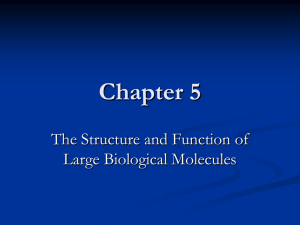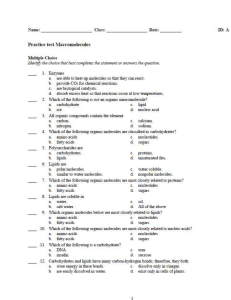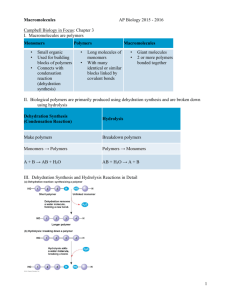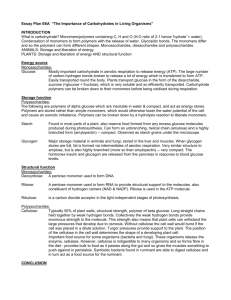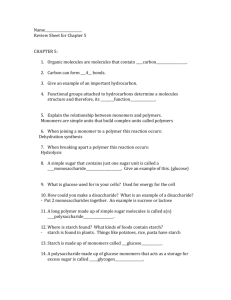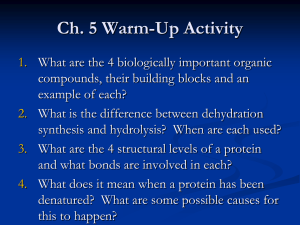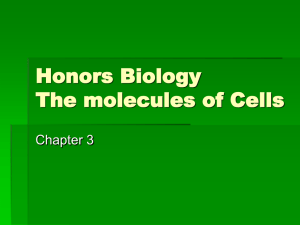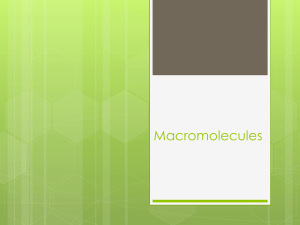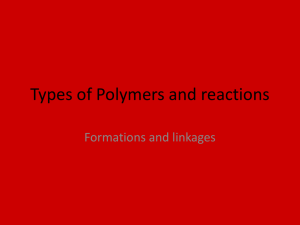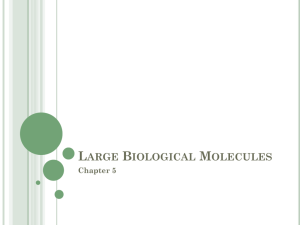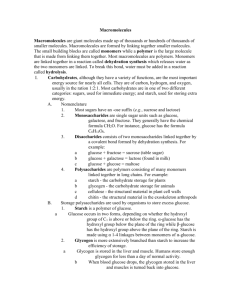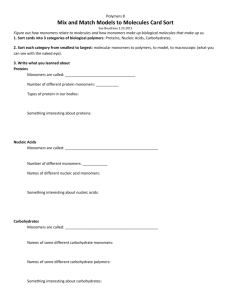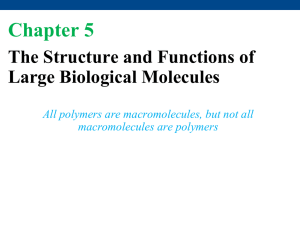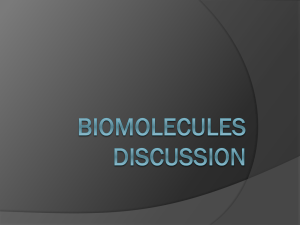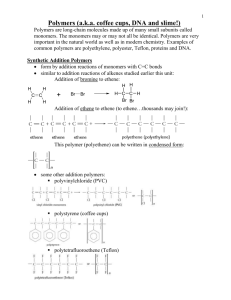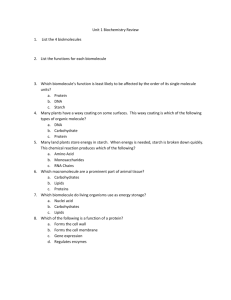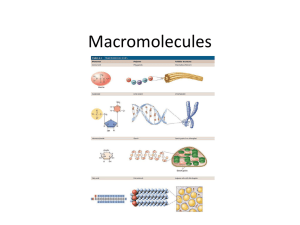Ch. 5 Macromolecules 9e X
advertisement
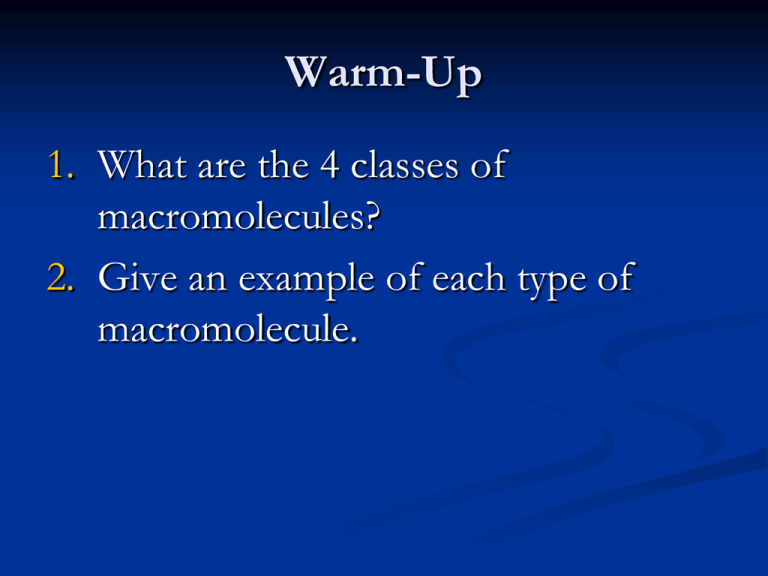
Warm-Up 1. What are the 4 classes of macromolecules? 2. Give an example of each type of macromolecule. Ch. 5 Warm-Up Activity In your family groups, complete #1-5 on Activity 4/5.1: “How can you identify organic macromolecules?” Warm-Up 1. What are the 4 levels of protein structure? What bonds are formed in each level? 2. Which protein was involved in the curds & whey lab yesterday? 3. Explain what happened to the milk to form the curds and whey. Chapter 5 The Structure and Function of Large Biological Molecules You Must Know • • • • • The role of dehydration synthesis in the formation of organic compounds and hydrolysis in the digestion of organic compounds. How to recognize the 4 biologically important organic compounds (carbs, lipids, proteins, nucleic acids) by their structural formulas. The cellular functions of all four organic compounds. The 4 structural levels of proteins How proteins reach their final shape (conformation) and the denaturing impact that heat and pH can have on protein structure Monomers •Small organic •Used for building blocks of polymers •Connects with condensation reaction (dehydration synthesis) Polymers Macromolecules •Long molecules of •Giant molecules monomers •2 or more polymers •With many identical or bonded together similar blocks linked by covalent bonds ie. amino acid peptide polypeptide protein smaller larger Dehydration Synthesis (Condensation Reaction) Hydrolysis Make polymers Breakdown polymers Monomers Polymers Polymers Monomers A + B AB AB A + B + + H2O + H2O + I. Proteins • “Proteios” = first or primary • 50% dry weight of cells • Contains: C, H, O, N, S Myoglobin protein Protein Functions (+ examples) • • • • • • • • Enzymes (lactase) Defense (antibodies) Storage (milk protein = casein) Transport (hemoglobin) Hormones (insulin) Receptors Movement (motor proteins) Structure (keratin) Overview of protein functions Overview of protein functions Four Levels of Protein Structure 1. Primary Amino acid (AA) sequence 20 different AA’s peptide bonds link AA’s Amino Acid • • R group = side chains Properties: • hydrophobic • hydrophilic • ionic (acids & bases) • “amino” : -NH2 • “acid” : -COOH Four Levels of Protein Structure (continued) 2. Secondary Gains 3-D shape (folds, coils) by H-bonding Alpha (α) helix, Beta (β) pleated sheet Four Levels of Protein Structure (continued) 3. Tertiary Bonding between side chains (R groups) of amino acids H bonds, ionic bonds, disulfide bridges, van der Waals interactions Four Levels of Protein Structure (continued) 4. Quaternary 2+ polypeptides bond together amino acids polypeptides protein Bonding (ionic & H) can create asymmetrical attractions Chaperonins assist in proper folding of proteins • • Protein structure and function are sensitive to chemical and physical conditions Unfolds or denatures if pH and temperature are not optimal change in structure = change in function II. Nucleic Acids Function: store hereditary info DNA • • • • • Double-stranded helix N-bases: A, G, C, Thymine Stores hereditary info Longer/larger Sugar: deoxyribose RNA • Single-stranded • N-bases: A, G, C, Uracil • Carry info from DNA to ribosomes • tRNA, rRNA, mRNA, RNAi • Sugar: ribose Nucleotides: monomer of DNA/RNA Nucleotide = Sugar + Phosphate + Nitrogen Base phosphate Nucleotide Nitrogen base 5-C sugar Purines A–T G–C Pyrimidines •Adenine •Guanine •Cytosine •Thymine (DNA) •Uracil (RNA) •Double ring •Single ring Information flow in a cell: DNA RNA protein III. Carbohydrates • • • • • • Fuel and building material Include simple sugars (fructose) and polymers (starch) Ratio of 1 carbon: 2 hydrogen: 1 oxygen or CH2O monosaccharide disaccharide polysaccharide Monosaccharides = monomers (eg. glucose, ribose) Polysaccharides: Storage (plants-starch, animals-glycogen) Structure (plant-cellulose, arthropod-chitin) Differ in position & orientation of glycosidic linkage The structure and classification of some monosaccharides Linear and ring forms of glucose Carbohydrate synthesis Cellulose vs. Starch Two Forms of Glucose: glucose & glucose Cellulose vs. Starch • • Starch = glucose monomers Cellulose = glucose monomers Storage polysaccharides of plants (starch) and animals (glycogen) Structural polysaccharides: cellulose & chitin (exoskeleton) II. Lipids A. Fats (triglyceride): store energy Glycerol + 3 Fatty Acids saturated, unsaturated, polyunsaturated B. Steroids: cholesterol and hormones C. Phospholipids: lipid bilayer of cell membrane hydrophilic head, hydrophobic tails Hydrophilic head Hydrophobic tail Saturated Unsaturated Polyunsaturated “saturated” with H Have some C=C, result in kinks In animals In plants Solid at room temp. Liquid at room temp. Eg. butter, lard Eg. corn oil, olive oil Cholesterol, a steroid The structure of a phospholipid Hydrophobic/hydrophilic interactions make a phospholipid bilayer
